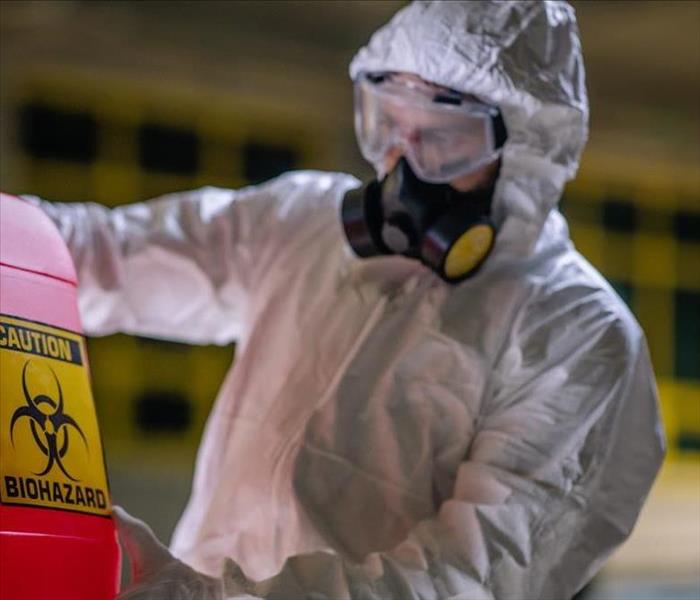Safety Tips For Biohazard Cleanup
5/2/2022 (Permalink)
Safety is ALWAYS at the front of our minds on any job here at SERVPRO of Biloxi, Gulfport, Ocean Springs, & Pascagoula – from biohazard cleanup to fire restoration. But the truth is, once our mind is focused on the job at hand, it’s easy to forget simple ways to keep ourselves and our team safe. OSHA, or the Occupational Safety and Health Administration, was established in 1971 to help ensure employees have a workplace free from recognized hazards. While OSHA does help with safety, no one agency can be responsible for the safety of everyone every day. It’s no secret safety issues increase following a fire, flood or other disaster. So it’s up to restoration contractors and technicians to understand the risks and be trained to handle them whether it be high levels of bacteria in a flooded home, or mold on a basement wall.
Basic Safety Risks
Here are some safety risks to consider specifically related to restoration and remediation work, and very simple safety tips to keep in mind:
- Structural integrity issues caused by fire or flood damage – do not walk on surfaces that are not stable.
- Possible exposures from toxic chemical substances generated during a fire or in flood water -- wear rubber boots and gloves.
- A variety of sharp metal objects, razor blades, jagged edges – use care when handling and clean any cuts or wounds.
- Breathing dust containing asbestos or other toxic materials – wear proper filtration masks.
- Eye injuries from flying debris, dust, contaminated water and cleaning chemicals – wear safety goggles.
- Carbon monoxide from propane or gas fired generators or other equipment – do not work in these areas.
- Ladders – avoid electrical wires, position at a safe angle; don’t place on unstable surfaces.
- Chain saws and other power tools– follow manufacturer’s instructions and don’t overreach.
- Trucks or other heavy equipment backing up or being moved – always be alert on the job.
- Remediating death scenes (may include blood or bodily fluids) – use gloves and other PPE (personal protection equipment) like hazmat suits.Highly Trained Restoration Specialists
- Our SERVPRO Professionals are highly trained in property restoration. From initial and ongoing training at SERVPRO's Corporate Training Facility to regular IICRC industry certifications, our Professionals are equipped with the knowledge to restore your property. The SERVPRO training program includes the follow:
Beyond PPEs
Now, let’s dive a little deeper. Workers must avoid exposures to microbial contamination and chemicals via skin contact, inhalation, and ingestion. This requires the use of PPE’s and good personal hygiene. Washing hands often and not eating in areas where work is being performed are two simple practices that should not be overlooked. Even with the proper PPE’s, physical and emotional stress can take a toll. Pace yourself and take frequent breaks. Keep a watchful eye on those helping with cleanup and be vigilant of your surroundings. Drink plenty of water in order to stay hydrated. Seek medical attention if your body temperature exceeds 103degrees Fahrenheit, you experience dizziness or nausea or you have other health concerns. Talk to your primary care physician about tetanus or other vaccinations you may need.
Handling Chemicals
Technicians should also be trained to select and use appropriate cleaning chemicals, disinfectants and protectors. For example, bleach, while readily available and inexpensive, is a caustic and hazardous chemical. It can cause harm to human skin and mucus membranes, is corrosive to metals, is readily inactivated by organic matter, produces irritating fumes, and can generate deadly chlorine gas or form explosive compounds if inadvertently mixed with ammonia or ammonia-containing products. The American Association of Poison Control Centers reported in 2004 that there were over 57,000 exposures, major or minor, reported from bleach across the United States. When using any chemical, care should also be taken to allow adequate dwell time for EPA registered disinfectants. All EPA labeled directions must be followed. Moreover, using a chemical that may be “safer” and less toxic may not be strong enough to inactivate target organisms. There is no doubt the most efficient method to stay safe is to constantly be aware of your work area surroundings and follow OSHA and industry guidelines. Safety is everybody’s job.
- IICRC Training
- Employee Certification Training
- Initial Franchise Training
- e-Learnings
- Continuing Education Classes

 24/7 Emergency Service
24/7 Emergency Service
